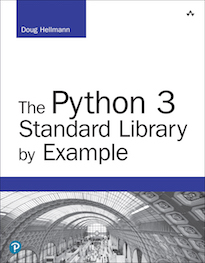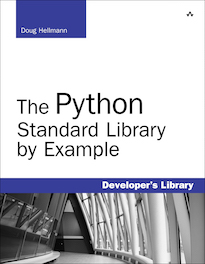pprint – Pretty-print data structures¶
| Purpose: | Pretty-print data structures |
|---|---|
| Available In: | 1.4 |
pprint contains a “pretty printer” for producing aesthetically pleasing representations of your data structures. The formatter produces representations of data structures that can be parsed correctly by the interpreter, and are also easy for a human to read. The output is kept on a single line, if possible, and indented when split across multiple lines.
The examples below all depend on pprint_data.py, which contains:
data = [ (i, { 'a':'A',
'b':'B',
'c':'C',
'd':'D',
'e':'E',
'f':'F',
'g':'G',
'h':'H',
})
for i in xrange(3)
]
Printing¶
The simplest way to use the module is through the pprint() function. It formats your object and writes it to the data stream passed as argument (or sys.stdout by default).
from pprint import pprint
from pprint_data import data
print 'PRINT:'
print data
print
print 'PPRINT:'
pprint(data)
$ python pprint_pprint.py
PRINT:
[(0, {'a': 'A', 'c': 'C', 'b': 'B', 'e': 'E', 'd': 'D', 'g': 'G', 'f': 'F', 'h': 'H'}), (1, {'a': 'A', 'c': 'C', 'b': 'B', 'e': 'E', 'd': 'D', 'g': 'G', 'f': 'F', 'h': 'H'}), (2, {'a': 'A', 'c': 'C', 'b': 'B', 'e': 'E', 'd': 'D', 'g': 'G', 'f': 'F', 'h': 'H'})]
PPRINT:
[(0,
{'a': 'A',
'b': 'B',
'c': 'C',
'd': 'D',
'e': 'E',
'f': 'F',
'g': 'G',
'h': 'H'}),
(1,
{'a': 'A',
'b': 'B',
'c': 'C',
'd': 'D',
'e': 'E',
'f': 'F',
'g': 'G',
'h': 'H'}),
(2,
{'a': 'A',
'b': 'B',
'c': 'C',
'd': 'D',
'e': 'E',
'f': 'F',
'g': 'G',
'h': 'H'})]
Formatting¶
If you need to format a data structure, but do not want to write it directly to a stream (for logging purposes, for example) you can use pformat() to build a string representation that can then be passed to another function.
import logging
from pprint import pformat
from pprint_data import data
logging.basicConfig(level=logging.DEBUG,
format='%(levelname)-8s %(message)s',
)
logging.debug('Logging pformatted data')
logging.debug(pformat(data))
$ python pprint_pformat.py
DEBUG Logging pformatted data
DEBUG [(0,
{'a': 'A',
'b': 'B',
'c': 'C',
'd': 'D',
'e': 'E',
'f': 'F',
'g': 'G',
'h': 'H'}),
(1,
{'a': 'A',
'b': 'B',
'c': 'C',
'd': 'D',
'e': 'E',
'f': 'F',
'g': 'G',
'h': 'H'}),
(2,
{'a': 'A',
'b': 'B',
'c': 'C',
'd': 'D',
'e': 'E',
'f': 'F',
'g': 'G',
'h': 'H'})]
Arbitrary Classes¶
The PrettyPrinter class used by pprint() can also work with your own classes, if they define a __repr__() method.
from pprint import pprint
class node(object):
def __init__(self, name, contents=[]):
self.name = name
self.contents = contents[:]
def __repr__(self):
return 'node(' + repr(self.name) + ', ' + repr(self.contents) + ')'
trees = [ node('node-1'),
node('node-2', [ node('node-2-1')]),
node('node-3', [ node('node-3-1')]),
]
pprint(trees)
$ python pprint_arbitrary_object.py
[node('node-1', []),
node('node-2', [node('node-2-1', [])]),
node('node-3', [node('node-3-1', [])])]
Recursion¶
Recursive data structures are represented with a reference to the original source of the data, with the form <Recursion on typename with id=number>. For example:
from pprint import pprint
local_data = [ 'a', 'b', 1, 2 ]
local_data.append(local_data)
print 'id(local_data) =>', id(local_data)
pprint(local_data)
$ python pprint_recursion.py
id(local_data) => 4299545560
['a', 'b', 1, 2, <Recursion on list with id=4299545560>]
Limiting Nested Output¶
For very deep data structures, you may not want the output to include all of the details. It might be impossible to format the data properly, the formatted text might be too large to manage, or you may need all of it. In that case, the depth argument can control how far down into the nested data structure the pretty printer goes.
from pprint import pprint
from pprint_data import data
pprint(data, depth=1)
$ python pprint_depth.py
[(...), (...), (...)]
Controlling Output Width¶
The default output width for the formatted text is 80 columns. To adjust that width, use the width argument to pprint().
from pprint import pprint
from pprint_data import data
for d in data:
for c in 'defgh':
del d[1][c]
for width in [ 80, 20, 5 ]:
print 'WIDTH =', width
pprint(data, width=width)
print
Notice that when the width is too low to accommodate the formatted data structure, the lines are not truncated or wrapped if that would introduce invalid syntax.
$ python pprint_width.py
WIDTH = 80
[(0, {'a': 'A', 'b': 'B', 'c': 'C'}),
(1, {'a': 'A', 'b': 'B', 'c': 'C'}),
(2, {'a': 'A', 'b': 'B', 'c': 'C'})]
WIDTH = 20
[(0,
{'a': 'A',
'b': 'B',
'c': 'C'}),
(1,
{'a': 'A',
'b': 'B',
'c': 'C'}),
(2,
{'a': 'A',
'b': 'B',
'c': 'C'})]
WIDTH = 5
[(0,
{'a': 'A',
'b': 'B',
'c': 'C'}),
(1,
{'a': 'A',
'b': 'B',
'c': 'C'}),
(2,
{'a': 'A',
'b': 'B',
'c': 'C'})]
See also
- pprint
- Standard library documentation for this module.

